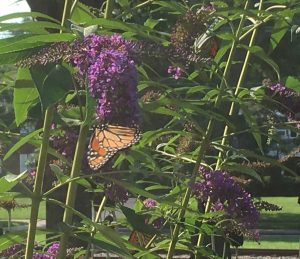
Monarchs on Buddleia ‘African Queen’
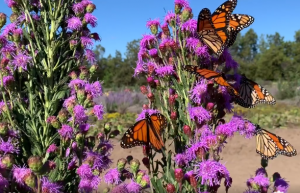
Monarchs on Liatris ligulistylis-hanshansen
Before I start telling you about Helenium, I have to share with you what a delight the past few days have been. A bevy of Monarchs has spent each day sucking nectar from the Buddleia inflorescences in the front yard. As you might imagine, photographing them is very difficult but I did manage a few decent shots. I was also mightily impressed with a photo of Monarchs on Liatris ligulistylis in Hans Hansen’s garden in western Michigan.
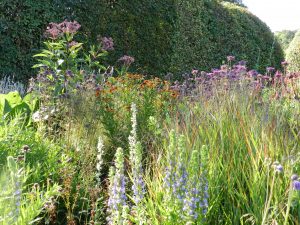
Piet Oudolf, the prominent Dutch landscape designer, has woven Helenium into his meadow garden along with Lobelia siphilitica, Eupatorium, Monarda and one of the red switch grasses.
Now, on to Helenium. Forget the notion that planting Helenium in the perennial garden will make you sneeze. This is a myth that has been fostered by the fact that ragweed blooms at the same time as Helenium, namely in late August and September, and is similar in appearance.
Actually, Helenium is one of those perennials that continue to make the perennial garden or a meadow colorful at the end of the summer even though temperatures have hovered in the stratosphere. Happily, it is not on the deer menu. If you elect to plant Helenium, you will either need to find a moist spot or irrigate because Helenium is a moisture lover.
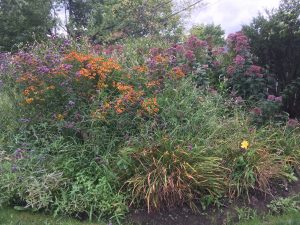
Helenium ‘Dancing Flames’is right at home as part of a stylized prairie along with Verbena bonariensis, Panicum ‘Northwind’, and Eupatorium dubium ‘Little Joe’.
Helenium autumnale (Common Sneezeweed) is native to the eastern United States and is the species best suited to the sunny gardens of Northeast Ohio. The older cultivars of Helenium, such as ‘Dancing Flames’, need to be placed at the back of the border because they grow three to five feet tall. They do not usually need staking unless overfertilized (none or very little is best) or watered insufficiently. If you need or prefer the plants to be shorter, you can cut them in half in mid-June. Such pruning will effectively make the plants bushier but will also delay bloom by a few weeks.
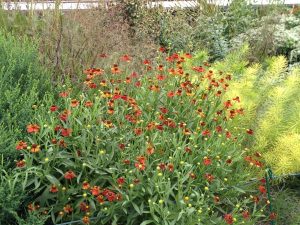
An older cultivar, Helenium x ‘Rubinzwerg’ (‘Ruby Dwarf’) demonstrates the fallacy of many of the names.This color can hardly be called ruby.
Formerly, the daisy-like flowers range included yellow, bronze, copper, orange, orangey-red, and mahogany with dark brown to black centers. Many of the older, tall cultivars have deceiving names like ‘Crimson Beauty’ and ‘Ruby Tuesday’. While these cultivars are red, the undertone is orange, not purple. Because of the color range of Helenium, they signify fall to me unlike the asters that are usually blues and purples but they play off each other quite well.
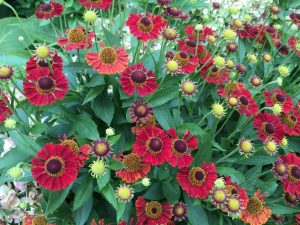
Helenium ‘Mariachi Salsa’ adds a vibrant color to the late summer/early fall garden. Note the flower at lower right that demonstrates the color when aged.
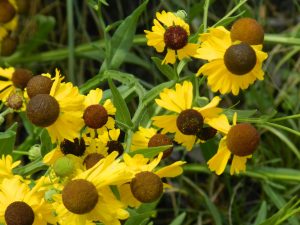
Unlike most Helenium flowers, those of ‘Tiny Dancer’ are softly drooping rather than stiff.
Happily, there are now shorter cultivars and some of them have been thriving in my garden. I am especially pleased with the Mariachi series. They tend to grow 18-20” tall. ‘Salsa’ is an orange-red, ‘Sombrero’ is yellow, ‘Fuego’ is orange with a yellow edge and yellow eye while ‘Siesta’ appears to be a true red. You can expect eight to ten weeks of bloom in late August, September, and October. Another dwarf is Helenium flexuosum ‘Tiny Dancer’. The yellow flowers are just as tall as those in the Mariachi series but the petals droop slightly, resembling ballet skirts, and the centers are more prominent.
Helenium is a perennial that benefits from good spacing since the foliage is dense. Supposedly, dividing it every two or three years would be beneficial but I’ve had mine since 2016 and it shows no signs of decline; in fact, it looks better than ever so I’m not touching it.
Assuming that you have a sunny, moist spot just waiting for a colorful, long-blooming perennial, I think you’ve found it. In addition, Helenium is a great alternative to the big blobs of Chrysanthemum that are sale in late summer and early fall and need to be replaced each year. Sadly, none of our local nurseries are growing the Mariachi series although Bluestone has a few other cultivars. You and the growers need to give Helenium a try.


0 Comments